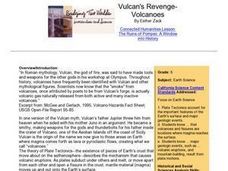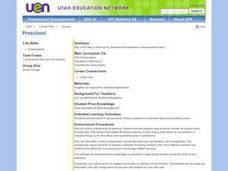Curated OER
Diatom Ooze
Students explore seafloor sediment. In this ocean environment lesson, students describe the characteristics of different types of seafloor sediment and oozes. They compare and discuss locations of sediments and oozes by plotting the...
Curated OER
Vulcan's Revenge-Volcanoes
Sixth graders research various types of volcanoes. They explore the various emissions that come from them. Offer some explanation why some erupt by "quietly" puring lava, while others blast out chunks of rock and clouds of ash and gases.
Curated OER
Landslides!
Students discover soil and Earth movement by experimenting in class. In this Earth Science lesson, students utilize a stream table, soil, graduated cylinder and water to create a re-enactment of a landslide. Students simulate...
Curated OER
Environment" The Mining Cycle
Students explore the world of mining and explain its importance in daily life. After describing how companies search for mineral deposits, they examine the environmental consequences of mining as well as the positive aspects. The...
Curated OER
How Does Your Magma Grow?
Students identify the three types of plate boundaries and the Earth's tectonic plates system. They examine how the Galapagos Islands were formed and hydrothermal vents.
Curated OER
Observing Objects
Students observe the motion of both a pendulum and a spring pendulum . They then explain the differences and the similarities between the two types of motions.
Curated OER
Preschool
Students experience various types of play. They determine play is the way a child learns and describe the value of play. They discover that play is a child's natural way of learning and that children test and practice new physical,...
Curated OER
Setting Up Equations
For this setting up equations worksheet, students solve 4 different problems that include setting up the equations in each problem. They write out an equation or set up an equations that describe each given situation. Then, students...
Curated OER
Edible Coal Mining
Learners explore the concept of bituminous coal and the role it plays within our world. In this economic and earth science instructional activity, learners discover and model the extraction methods with hands-on activities. ...
Curated OER
Soil Formation
Seventh graders investigate how soil is formed. They analyze types of soil samples, examine soil using a magnifying glass or microscope, complete a chart, conduct a soil and plant experiment, and construct a soil profile.
Curated OER
Erosion and Deposition
Fifth graders study the processes of erosion, transportation, and deposition in soil. They walk outside the school to see examples and then accurately create a physical model which shows each type of soil movement and allows them to...
Curated OER
The Goat in the Rug
Students write a personal narrative about something they produce at home. (examples: make a sandwich, clean room, set table, do homework). Students should remember to mention different types of resources and intermediate goods used.
Curated OER
Glaciers
In this glaciers worksheet, students complete 12 different questions related to glaciers. First, they complete the 2 tables that illustrate the similarities and differences between continental and valley glaciers. Then, students identify...
Curated OER
Nebraska's Wild Weather
Learners examine the weather in Nebraska. Using this information, they describe the cause and effect relationships in the environment based on these changes in weather. They write various types of poems with weather themes and share them...
Curated OER
Energy Resources
In this energy worksheet, students will review the different types of energy and how energy can be created and conserved. This worksheet has 10 matching and 11 short answer questions.
Curated OER
Transpiration
Students interactively explore the term transpiration. In this science/ecology lesson, students discuss what they would do if they were thirsty while conducting research in Brazil. Additionally, students write descriptive words to...
Curated OER
Structure of the Earth System
Eighth graders describe the steps in the water cycle. They discuss factors that affect runoff and explain the differences between stalactites and stalagmites. They discover the importance of ground water.
Curated OER
Studying Aquifers in Outcrop
Students describe two or more different rock types found in outcrop. Students look specifically at the hydro-geologic properties of the rocks and complete the lab with a paper explaining a scientific phenomenon in layperson terms.
Curated OER
Sedimentation
Learners are introduced to the various types of sedimentation. In groups, they define the term and research what causes it to happen. They compare and contrast the different types of sedimentation and research how it occurs off of Cape...
Curated OER
Three-dimensional cooperative modeling
Middle schoolers explore what is present below the surface in order to drill into the ground and record the type of material that the drill brings to the surface. They discuss the benefits and drawbacks of distance communications. ...
Curated OER
Aquifers and Recharge Areas
Students create a model of an aquifer and describe how an aquifer works. They describe how running affects an aquifer and prepare a model presenting to local planners the important aspects of protecting recharge areas.
Curated OER
Developing a Local Stratigraphy
Students examine rock strata for the distribution, deposition, and age of sedimentary rock. They describe rock types in a variety of outcrops and construct a regional stratigraphy.
Curated OER
A Whole Lot of Shakin' Goin' On!
Students gather data about the 1906 and 1989 earthquakes, make comparisons between the two, and determine the factors that influence the amount of shaking that occurs in an area due to an earthquake. They identify that the distance is...
Curated OER
Glaciers Leave Their Imprint
Students study various types of glaciers and the landforms they create. Working in pairs, they research a type of glacial landform and construct a calendar page illustrating and describing it. The pages be compiled to create a class...

























